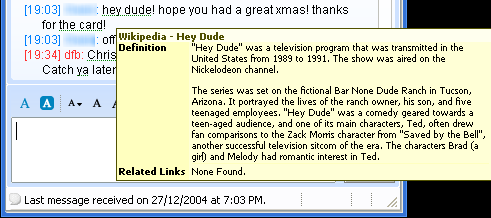Oh, very cool. PC cases made of Lego.
(via Fan-Fugu-Tastic).

Oh, very cool. PC cases made of Lego.
(via Fan-Fugu-Tastic).
Just noted some comment spam with this in the name field:
online poker
which displays as
online poker
Sneaky hey.
From my limited testing (I had to find a workaround pronto) seems to be some kind of bug when using VB6, ADO 2.7, ODBC text driver to read from an Excel spreadsheet. Recordsets with date fields come in with the dates encoded as integers. This is normally no problem, as you can use IsDate to check if it’s valid, then CDate to convert it to a date.
But what I’ve found is that IsDate has stopped working… that is, it’s stopped returning True for field values that can be converted to dates, eg CDate works. Whether this is something to do with the new year, or a new version of something on my machine, I haven’t yet figured out, but I ended up writing a wrapper IsDate function that just tries the CDate regardless, and returns a False (eg not a date) if it errors.
An initial dig in the MSKB found nothing about it, but I’ll do some more exhaustive digging and try to get a definite answer later. The answer being, I suspect, “Switch to VB.Net, you luddite!”
For a while back in the 90s, it seemed like Java would be the last word in interactive web pages, animations, etc etc. Every second web site had some kind of irritating Java applet animated banner.
But it’s faded. In its place we have Flash. It’s not quite write-once, run-anywhere… but it is write once, run on PC, Mac, Linux and Solaris. Which anyway you look at it is just about all of the browser market.
Java still finds a home on mobile devices, and for server development, but is becoming less common on web sites, particularly since it stopped being bundled with IE/Windows.
Perhaps Flash has the upper hand because a lot of web development with heavily interactive content (particularly advertising) is driven by graphic designers and multimedia people rather than programmers, giving Macromedia an advantage over Sun.
Now, if only there could be a ban on developing complete sites in Flash.
So, how did I go with Partition Magic?
Eventually got there. At first I tried to merge my full D: partition with my adjacent empty E:. It didn’t want to do it, kept giving me an error message:

I freed up 125Mb or so on D: drive, then tried again. Same error. Was I seeing things? It was saying 121Mb or so, wasn’t it? Not 1.2Gb? I freed up more, eventually having some 450Mb free. Still no go. Frustration.
So instead I deleted the empty E: partition and then resized D:. That worked a treat, but I’m still not clear why merging didn’t work.
I also converted the FAT C: to NTFS while I was mucking about. That worked flawlessly.
In conclusion, PM seems pretty good, but some doubt (at least for me) about merging partitions.
Not the mini-mini-iPod, oh no. And not the iPod Lite. Or the Tiny iPod. No, it’s the iPod shuffle, a new model with just 512Mb (A$149) or 1Gb (A$229) of space.
Though I notice Apple’s AU web masters appear to have just copy/pasted from their US site… the Alt text for the advert proclaims “from $99” … anybody going to try and take them up on that?

Apple is expected tomorrow to announce the introduction of an Australian iTunes music store to coincide with the start of its annual MacWorld conference in San Francisco.
Full story at The Age (free registration required) or MacDailyNews.
I haven’t tried it yet, but you can get it here. It’s Win2K or XP only, ‘cos damn those NT4 and Win9X users, they deserve everything they get for not upgrading…
(via Patrick)
Hey that kinda rhymes.
Couple of my WordPress installations are under attack. Until I clean them up, you may see some offensive trackbacks/comments in some old blog posts.
Continue reading
Got myself a new hard disk for one of my computers, which was suffering from eternally insufficient space. The installation itself was pretty straight forward. Figure out the whole primary/secondary master/slave situation, and you’re away. Easy. Mind you, the manual did recommend moving the jumper with pliers… which broke it. Oh well, it was going in as a slave, for which I didn’t need a jumper in place.
Booted up, plonked in the Maxtor CD that came with the drive and it formatted in a jiffy, one sparkly new drive ready for business. (What, you thought this was going to be a doom and gloom blog?)
Then I pondered fiddling with the partitions on the old drive. When I had set it all up several years ago, I had decided that separate partitions were a good idea. The idea was you could have a C: for Windows and your programs, and a D: for all your data, making it much easier to backup.
That’s okay in theory, but in practice, three things can go wrong:
So after installing the new drive (G: of course) I pondered re-partitioning to at least get the space from F: glomped in with C:. I won’t bother fiddling D: until Windows gets re-installed.
 Partition Magic has a reputation as being the defacto/best-of-breed partition management app. (If anybody knows of anything better, I’d be interested to hear about it. I do recall hearing about a good freeware one, but can’t remember what it was called…)
Partition Magic has a reputation as being the defacto/best-of-breed partition management app. (If anybody knows of anything better, I’d be interested to hear about it. I do recall hearing about a good freeware one, but can’t remember what it was called…)
PowerQuest, who make Partition Magic (and whom suffered through credit card fraud using my card once) got bought out by Symantec recently. You can buy and download it from Symantec AU for A$109.05. Meanwhile their US operation will charge you US$49.95 (AU$65.48) for the same thing… grrrr.
It seems to retail at places like Harris Technology for about A$90. (HT is my benchmark for retail prices, since they’re generally reasonably competitive — moreso than their Officeworks stablemate — have a good range of products, and a web site that’s easy to use.)
I happened to glance around the web and found a few other companies purporting to sell download versions of Partition Magic. The most intriguing of these was a mob called ibackups.net, who have a variety of software at what one might argue are “too good to be true” prices. A little Googling on this mob led me to their T+Cs, where hidden away down near the bottom in dot point 9.1 is this:
9.1 You understand that in order for iBackups.net to make you a copy of any software, you acknowledge that you are the legal owner of this same software, and are looking to just make a new copy for archival (backup) purposes only. You also agree to destroy all copies of the software in the event it is ever no longer voluntarily in your possession. You understand that only the licensed owner (with a valid serial number, where applicable) of the various software found on iBackups.net may use the services located here. You also acknowledge that the software you have was obtained legally and that you have the legal right to request this backup copy to be made. If you obtained your version though any other means, including any pirated versions, or if you do not already legally own the same version of the software requested, then you may not use this service.
They’re not selling software, they’re not selling a license to use software. They’re selling you a backup of software you’re already supposed to own. And indemnifying themselves if you don’t:
Furthermore, you agree to hold iBackups.net harmless for any damages that may occur for your failure to follow the U.S. Copyright and other laws as they pertain to the backup you are requesting. When you purchase any backup copy of software through iBackups.net, you agree to assume full liability in the event your actions are deemed illegal. iBackups.net does not condone software piracy and has every intention of complying with the laws pertaining to the duplication of software.
One could very well ask if they’re just selling backups, why do the prices vary so much? US$49.95 for Acrobat 5, but US$119.95 for Acrobat 6 Pro? And why do their product listings compare their price to the “retail price”, if what they’re selling is in no way comparable to the retail product?
No doubt there’s legitimate people who would be in need of such a service, but this sounds very close to the line, and they certainly give the impression they’re just selling software, not backups. They must have good lawyers.
I think I’ll keep shopping. Maybe I’ll just mosey around the city and find it the next time I’m there.
Actually, I don’t see anything on the Symantec US web site saying they won’t let me download to Australia…
Update at Noon. In fact Symantec US will happily sell to just about anywhere, judging from their web form, which includes Australia in the country dropdown. They will let you download for a year if you pay an extra US$6.99, which I chose to take, though on reflection I probably shouldn’t have… maybe worthwhile if that includes upgrades though. (Default is downloads allowed for 60 days). Oh well, US$56.94 = A$74.51 beats any AU retail price I might be able to find, even after I spend an extra 50 cents burning it to a CD.
Dave Barry on computer security:
I am beginning to suspect that the way “antivirus” and “firewall” software protects you is that it makes it basically impossible for your computer to (1) send email; (2) receive email; (3) use your home network; or (4) contact the Internet in any manner. It’s a lot like turning your computer off, except you have to pay for it, and then periodically pay to “update” it so that it can continue effectively preventing you from using your computer.
Not that I am frustrated or anything.
(via Lauren)
Happy new year!
One Trillian 3 feature that seems largely pointless is that it does Wikipedia lookups of some words. Hmmmm. I suppose it could occasionally be useful, but I don’t know how it chooses the words to lookup, and Wikipedia may not always be the first choice for finding what the word means in context.
For instance:

That would have to count as one of the most out-of-context, inaccurate and pointless definitions I’ve ever seen. Thus, I’ve turned that option off.